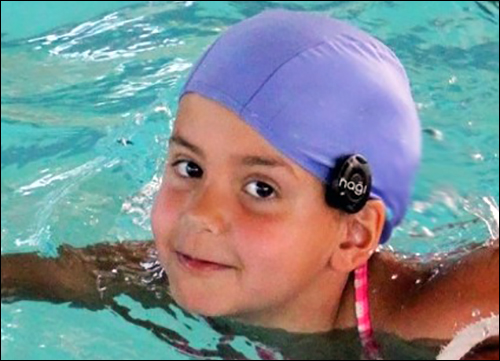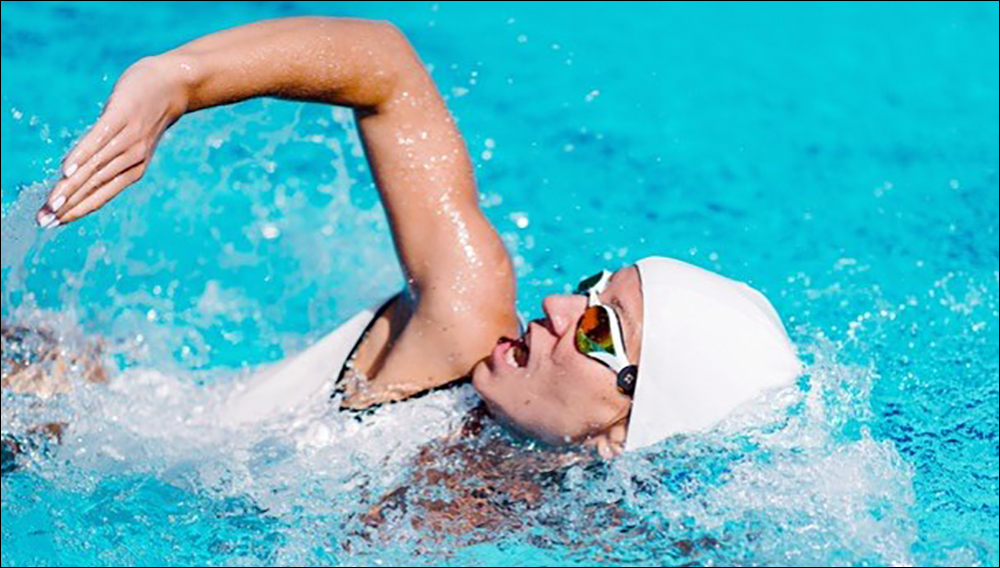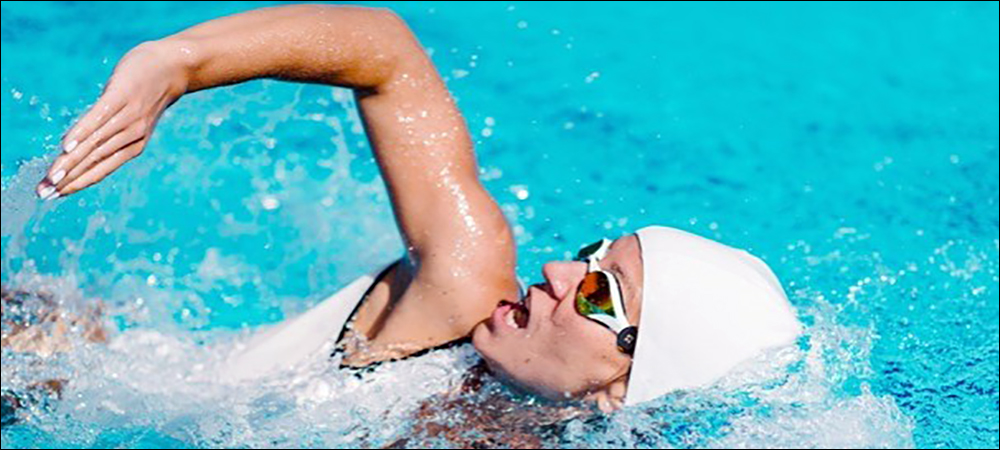Sports technology company Nothingbutnet (NBN) has released a social-distancing solution that builds on the real-time location system (RTLS) it already offers for basketball (NBN23) and aquatics (Nagi Smartpool). The company’s new Soocial solution captures data and delivers content regarding the locations of swimmers or other athletes, as well as individuals in offices or factories, to boost safety during the COVID-19 crisis. All of NBN’s RTLS solutions leverage location data from Quuppa Bluetooth Low Energy (BLE) sensors and tags to identify where individuals are located, and (in the case of Soocial) when they come within close contact and for how long.
The Dean & Barbara White Southlake YMCA, a branch of Crossroads YMCA located in Crown Point, Ind., has already been using NBN’s Nagi solution to capture location data regarding swimmers. The collected data can help swimmers monitor their own speed and other performance metrics. Later this year, the organization plans to launch the Soocial functionality as well, in order to provide an additional level of safety for its users, with social-distancing tracking. Headquartered in Spain, NBN was launched in 2014 and now offers three solutions: Nagi Smartpool for swimmers, NBN23 for basketball performance management and now Soocial for social distancing and contract tracing.
 The NBN23 solution was aimed at tracking the movements of basketball players on a court, so as to provide teams, players and coaches with content regarding player performance, according to Ed Dvorak, NBN’s Nagi global general manager. In fact, the technology has been endorsed by the National Basketball Association (NBA) for use during practice sessions. In 2016, the Nagi solution was released for the aquatics environment to help manage swimmers internationally, and was released in the United States in 2019.
The NBN23 solution was aimed at tracking the movements of basketball players on a court, so as to provide teams, players and coaches with content regarding player performance, according to Ed Dvorak, NBN’s Nagi global general manager. In fact, the technology has been endorsed by the National Basketball Association (NBA) for use during practice sessions. In 2016, the Nagi solution was released for the aquatics environment to help manage swimmers internationally, and was released in the United States in 2019.
Each Nagi Smartpool deployment consists of a nagiTag with a built-in Quuppa transmitter worn by a swimmer, basketball player or other individual, as well as nagiLocators, also powered by Quuppa technology, installed above and around a pool or a court. The locators receive signals from the tags and the system uses Quuppa positioning server software to calculate each beacon tag’s location as it moves around an area. That location data is then forwarded to the cloud-based nagiServer, where the information is managed and alerts are generated. “Quuppa provides submeter accuracy in real time,” says Tom Ruth, Quuppa’s VP for the Americas.
Since NBN launched the Nagi technology for aquatics, Dvorak says, “It’s been growing ever since.” There are two applications, he explains: Nagi Guard for swimming safety and Nagi Go for tracking performance. Athletes can view their speed, as well as how many lengths they complete, and gamify that information by comparing it to swimming the English Channel, for instance. The safety version provides insurance benefits for operators, along with added security, by automatically identifying a problem based on a swimmer’s tag transmission. The Nagi Guard solution was first deployed by Spanish fitness club Gofit, and the company has since expanded globally. Last year, the technology was introduced in the United States.
A swimmer participating in the system receives the nagiTag and attaches it to his or her googles or bathing cap. The unique ID number is transmitted via Bluetooth to a specific individual, depending on his or her needs. The tag can be set to transmit a signal at specific intervals, multiple times every second. As the swimmer moves around the area, the locators receive the beacon transmission, then forward that information, along with the location data, to the software, which then interprets the individual’s position within centimeters.
If the individual is swimming, the data continues to be sent; however, if the tag is fully submerged, it will stop transmitting. That break in transmission can enable the system to identify a safety problem if the tag remains underwater for a specified amount of time. This safety feature is intended as a level of security additional to the use of lifeguards.
 For those using the performance version of the solution, the technology can detect a swimmer’s speed, pace, time in water, and number of laps in real time as she or he travels up and down a pool’s lanes. That data is managed in the software to help swimmers view their performance. They can then access that data via a portal or app. The pools display the information on a 70-inch screen at the site in real time. In that way, they can monitor lap speed and thereby view their performance level.
For those using the performance version of the solution, the technology can detect a swimmer’s speed, pace, time in water, and number of laps in real time as she or he travels up and down a pool’s lanes. That data is managed in the software to help swimmers view their performance. They can then access that data via a portal or app. The pools display the information on a 70-inch screen at the site in real time. In that way, they can monitor lap speed and thereby view their performance level.
The Dean & Barbara White Southlake YMCA was the first U.S.-based adopter of the solution. With hundreds of swimmers, it can offer to deploy the technology as a way for recreational or student athletes to track their own improvement. The Soocial technology, Dvorak says, can plug into an existing Nagi Smartpool solution for another level of visibility that can help to ensure the safety of those in a pool or pool area during the pandemic. The Centers for Disease Control and Prevention has found little evidence of COVID-19 spreading in pools. That, in part, could be due to the disinfection that is performed using chlorine and bromine.
Some pools, however, still seek to boost security by providing social distancing in and outside the water between two individuals, Dvorak says. With the NBN solution, the software analyzes the collected data and can issue alerts if individuals come within close proximity to each other for an extended period of time. For instance, he adds, if swimmers talk to each other for more than a specified duration (15 seconds, for example), the wearable tags will automatically light up as a subtle reminder to separate.
The data could also be used for contact tracing if an individual were to receive a positive test result and report that information. If the person’s tag were being tracked, the software could enable a pool’s management to view who may have been exposed to him or her. “Providing social distancing and contact tracing is a logical extension for the technology,” Ruth says, for those using the NBN and Quuppa tags, locators and software. “We’re already able to track what is happening in the area in real time.”

Tom Ruth
NBN’s solution competes with numerous RFID- or IoT-based systems that monitor social distancing. Ruth says Soocial provides full real-time location, as opposed to other systems designed to be quickly deployed with little infrastructure and less visibility. Many of these more passive systems, he adds, “will measure distance between two people and alert them to tag-to-tag or peer-to-peer associations.” That data is either cached or sent to a gateway, so the location of the event is unknown.
Those without gateways will lack real-time location data, Ruth says. What’s more, he adds, the Quuppa data is highly granular, which makes it more accurate. “A second challenge is false positives,” he states, “especially if they are measuring signal strength.” The risk of gaining too many alerts when the location data is not highly accurate is “a challenge we’re mitigating, because if people get too many false positives, they start to ignore the tool.”

Ed Dvorak
Unlike many social-distancing solutions released since the pandemic began, Dvorak notes, Nothingbutnet’s system is intended for multiple use cases. “You don’t bring in one technology to solve one problem, and another technology to solve another,” Ruth states. Instead, the NBN system is designed to provide solutions beyond social-distancing applications, and it offers real-time location, with power low enough to enable a long battery life in the tag.
For offices, Soocial is intended to enable the capturing of data used beyond social distancing, for the purpose of space management. Dvorak cites statistics indicating that as many as 30 percent of employees may not return to office spaces post-pandemic. “That could mean rethinking layout of space,” he states. As such, the system could be employed to better understand how a particular space is being utilized.


